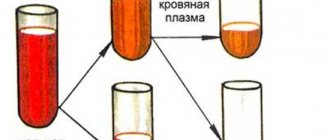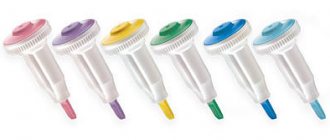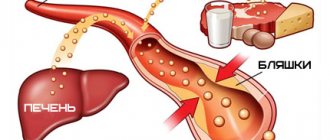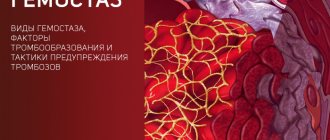History of education
The European Society of Cardiology (ESC) is a medical society founded in Brussels in 1949 on a voluntary basis.
It is a global non-profit, independent, non-governmental organization that identifies trends in cardiovascular disease and works to eliminate inequalities in the quality of care for patients in different countries. The ESC website is a source of high-quality, evidence-based medical information that expands knowledge in the field of cardiovascular disease.
The ESC was founded by the merger of 14 European National Communities in 1950.
The European Heart Association is committed to a code of conduct to ensure objectivity, transparency and integrity of the community. This statute was developed jointly with the Alliance for Biometric Research in Europe (an organization created in collaboration with the ESC).
Moderate coffee consumption in middle-aged people reduces the risk of cardiovascular complications and death
The observational study included 468,629 UK residents aged 40–69 years without diagnosed cardiovascular disease. Patient data were obtained from the UK Biobank. Based on questionnaires, average coffee consumption was estimated. Depending on the amount of coffee consumed, 3 groups of participants were identified: those who do not drink coffee, those who consume 0.5-3 cups per day, and those who consume 4 or more cups per day. It has been shown that moderate coffee consumption (0.5-3 cups per day) is associated with a 21% reduction in stroke, 17% in cardiovascular death, and 12% in overall death over the next decade; the analysis was carried out taking into account classical CVD risk factors. Increased coffee consumption is not associated with a protective effect, but does not increase the risk of cardiovascular events.
Cardiac MRI data were available for 30,650 patients, which showed that moderate coffee consumption was associated with more favorable anatomical and functional parameters (end-systolic and end-diastolic volume, output, and myocardial mass).
In an interview with Medscape, the author also explained that “natural” coffee turned out to be the most beneficial, but even for instant and even decaffeinated coffee, a connection was demonstrated between their consumption and a decrease in overall mortality.
This study did not show an association between coffee consumption and the risk of myocardial infarction or the development of cardiac failure. The association with the risk of AF has not been studied.
Because the study is observational, the causal relationship between coffee consumption and a favorable prognosis is not clear, so this study cannot be a basis for recommending coffee consumption. However, this study again indicated that there was no obvious “harm” from coffee.
1) e-Poster, abstract ESC 2021 J. Simon, et al. “Association of daily coffee consumption with cardiovascular health - Results from the UK Biobank” 08/27/21
https://esc2021-abstract.medicalcongress.online/
2) Low-to-Moderate Coffee Intake in Midlife Tied to Heart Benefits - Medscape - Aug 28, 2021
https://www.medscape.com/
Salt substitute consumption reduces risk of stroke, major cardiovascular events and death: SSaSS study
Salt substitutes, in which part of the sodium chloride is replaced by potassium chloride, have been available on the market for quite some time and are recommended for patients with arterial hypertension. However, there was no previous data confirming the positive effect of low-sodium salt on “hard” endpoints - stroke, MI, death, etc.
The SSaSS study, an open-label study with cluster randomization, was carried out in 600 villages in China. A total of 20,995 patients who had previously suffered a stroke (72.6%) or suffered from arterial hypertension and were aged 60 years or older were included. In the study group, patients received a salt substitute containing 25% potassium chloride and 75% sodium chloride, while patients in the control group took regular salt.
The mean follow-up time was 4.74 years. Salt substitute use was associated with a significant reduction in the incidence of stroke (RR 0.86; 95% CI 0.77 - 0.96; P = 0.006), major cardiovascular events (RR 0.87; 95% CI 0.8 - 0.94; P < 0.001) and death from all causes (OR 0.88; 95% CI 0.82 - 0.95; P<0.001). The incidence of hyperkalemia did not differ significantly between groups.
1) B.Neal “SSaSS: Salt Substitute and Stroke Study into the effect of salt substitutes on cardiovascular events and death” 08/29/21 Presentation, discussion
https://digital-congress.escardio.org/
2) Effect of Salt Substitution on Cardiovascular Events and Death. NEJM DOI: 10.1056/NEJMoa2105675
https://www.nejm.org/
AV node ablation and biventricular pacing reduces mortality in patients with heart failure, highly symptomatic persistent atrial fibrillation, and narrow QRS complex: the APAF-CRT trial
Ablation of the AV node and permanent pacing is one of the treatment options for patients with symptomatic persistent atrial fibrillation when drug reduction therapy is not possible. Right ventricular pacing may cause ventricular dyssynchrony, which may offset the hemodynamic benefits of achieving normosystole, especially in patients with heart failure.
The open-label, randomized APAF-CRT trial included patients with highly symptomatic AF lasting at least 6 months, hospitalized for CHF at least once during the previous year, and a narrow QRS complex (≤110 ms). A total of 133 patients were included. Patients in the main group underwent AV node ablation and pacemaker implantation with biventricular stimulation. The study was stopped early due to the obvious advantages of invasive treatment compared with the drug therapy control group; at this stage, the median follow-up time was 29 months. Ablation + CRT was shown to reduce the risk of death from all causes (OR 0.26, 95% CI 0.10–0.65; P = 0.004]. The estimated incidence of death in the study and control groups at 2 years was 5% and 21%, respectively; after 4 years - 14% and 41%. The benefits of such tactics did not depend on LVEF. The frequency of the secondary endpoint death + hospitalization due to decompensated CHF was also significantly lower in the ablation + CRT group (29% vs. 36 51%; OR 0.40 , 95% CI 0.22–0.73; P = 0.002].
1) APAF-CRT: AV junction ablation and CRT in patients with permanent atrial fibrillation and narrow QRS. Report by Michele Brignole 08/28/21. Presentation, discussion:
https://digital-congress.escardio.org/
2) Michele Brignole, et al. AV junction ablation and cardiac resynchronization for patients with permanent atrial fibrillation and narrow QRS: the APAF-CRT mortality trial, European Heart Journal, 2021;, ehab569,
https://doi.org/
For patients at high risk of bleeding, 1 month of dual antiplatelet therapy after PCI with implantation of sirolimus-eluting bioabsorbable polymer stents (Ultimaster©) is sufficient: the MASTER DAPT trial
MASTER DAPT is the first randomized trial to evaluate the optimal duration of dual antiplatelet therapy (DAPT) after PCI with drug-eluting stent implantation in patients at high risk of bleeding (without identifying patients at low risk of ischemic complications).
This study had its own criteria for high bleeding risk, which included the need for long-term use (more than 12 months) of anticoagulants; taking NSAIDs, GCS; PRECISE-DAPT more than 25 points; history of clinically significant bleeding within 12 months, or hospitalization due to bleeding if the source has not been eliminated; anemia (hemoglobin less than 11 g/dL or recent blood transfusion), age over 75 years; history of stroke; TIA within 6 months; cancer with a high risk of bleeding; systemic conditions with an increased risk of bleeding (for example, a history of recent thrombocytopenia less than 100 thousand / μl). Patients meeting these criteria were randomized one month after PCI to either switch to antiplatelet monotherapy or continue DAPT for at least an additional 2 months. The choice of antiplatelet agents in DAPT, as well as the choice of drug as part of monotherapy, was at the discretion of the attending physician (clopidogrel was most often used). A total of 4434 patients were included (half with ACS as the cause of index PCI), and the follow-up period was 335 days.
It was shown that the total incidence of adverse events (death/myocardial infarction/stroke/major bleeding) did not differ significantly between groups: 7.5% versus 7.7%, for the hypothesis of “monotherapy is not inferior to DAPT” (p < 0.001). The incidence of death and ischemic complications (stroke, MI) also did not differ between groups: 6.1% versus 5.9%, for the hypothesis “monotherapy is not worse than DAPT” p = 0.001. Finally, the monotherapy group had significantly fewer major and clinically significant bleeding events (6.5% vs. 9.4%, for the “monotherapy is better than DAPT” hypothesis p < 0.001). However, the benefits were achieved due to clinically significant bleeding; the incidence of major bleeding BARC 3-5 did not differ significantly between groups.
A limitation of this study is the type of stent used, which is not currently commonly used. It is not entirely clear whether the results of this study can be extrapolated to other types of stents, both 3rd - 4th and 2nd generations.
1) MASTER DAPT: dual antiplatelet therapy after coronary stenting in high bleeding risk patients. Report by Marco Valgimigli 08.28.21. Report, discussion:
https://digital-congress.escardio.org/
2) Dual Antiplatelet Therapy after PCI in Patients at High Bleeding Risk. NEJM DOI: 10.1056/NEJMoa2108749
https://www.nejm.org/
Reducing DAPT to one month showed no benefit in patients with ACS: STOPDAPT-2 ACS trial
The STOPDAPT 2 trial demonstrated the benefits of shortening the period of DAPT (aspirin + clopidogrel) to 1 month after PCI. This study included only 38% of patients with ACS, which served as the basis for organizing the STOPDAPT 2 ACS study.
This study included patients who, due to ACS (usually ST-segment elevation MI), underwent PCI with implantation of a stent on a cobalt-chromium platform coated with everolimus. Patients receiving anticoagulants, previous hemorrhagic stroke, or serious events during hospitalization were not included. Patients were randomized to receive aspirin and clopidogrel for a month followed by clopidogrel, or to receive DAPT for 12 months. The analysis included 4169 patients (including those previously enrolled in the identically designed STOPDAPT 2 trial). It was shown that reducing the duration of DAPT did not reduce the incidence of a composite endpoint reflecting the overall clinical effectiveness (cardiovascular death, MI, stroke, stent thrombosis, major and minor bleeding). The incidence of these events in the DAPT reduction group was 3.2% vs. 2.8% in the full therapy group (OR 1.14, 95% CI 0.80-1.62, p noninferiority = 0.06). A reduction in the duration of DAPT was associated with an almost doubling of the incidence of myocardial infarction: 1.6% vs. 0.9% (OR 1.91, 95% CI 1.06-3.44, p < 0.05), as well as a trend towards an increase in the frequency of the combined end point reflecting ischemic complications (CV death, MI, stroke, stent thrombosis): 2.8% vs.1.9% ( OR 1.50, 95% CI 0.99-2.26). Expectedly, reducing the duration of DAPT resulted in a reduction in the incidence of BARC 3-5 bleeding: 0.5% vs.1.3% (OR 0.41, 95% CI 0.20-0.83).
Hirotoshi Watanabe “STOPDAPT-2 ACS: one-month dual antiplatelet therapy followed by clopidogrel monotherapy in acute coronary syndrome”, reported 08/30/21.
https://digital-congress.escardio.org/
Target SBP less than 130 mm Hg. Art. in persons 60–80 years of age is associated with a reduction in the incidence of cardiovascular events: the STEP study
The target level of SBP in elderly patients is the subject of debate; various professional societies formulate recommendations on this topic differently: from reducing SBP to less than 130 mm Hg. until maintaining the target range of 130-<150 mmHg.
More intensive antihypertensive therapy is associated with a reduction in the incidence of cardiovascular events, but may be associated with a higher incidence of side effects and less adherence to treatment.
The randomized STEP trial included 9624 patients. In patients of the main group (intensive treatment), the target SBP level was 110-<130 mm Hg, in patients in the control group - 130-<150 mm Hg. In addition to office BP measurements during visits, this study used a special application that made it possible to monitor BP levels at home. The median follow-up duration was 3.34 years. Intensive antihypertensive therapy was associated with a reduction in the incidence of the composite endpoint of stroke/acute coronary syndrome/acute circulatory failure/coronary revascularization/atrial fibrillation/cardiovascular death (OR 0.74; 95% CI 0.60 to 0.92; P=0.007). There was also a significant decrease in the frequency of some individual components of the combined endpoint - stroke, ACS, acute decompensation of the urinary tract.
As expected, the intensive therapy group had a higher incidence of episodes of hypotension, while the incidence of other side effects, including renal dysfunction, did not differ significantly between the groups.
1) B. Williams “STEP Study: intensive vs. standard blood pressure control among older hypertensive patients,” reported 08/30/21. Report, discussion: https://digital-congress.escardio.org/
2) Trial of Intensive Blood-Pressure Control in Older Patients with Hypertension. NEJM DOI: 10.1056/NEJMoa2111437
https://www.nejm.org/
Clinical outcomes of left atrial appendage occlusion with older generation Amplatzer Amulet and Watchman devices are comparable, technical success is slightly higher with Amplatzer: Amulet IDE study
This randomized study was the first to directly compare two types of occluders: the Amplatzer Amulet and the Watchman (the penultimate generation modification that was approved at the time the study was planned). In the postoperative period, included patients (n=1878) received the following antithrombotic therapy: for Amplatzer aspirin + clopidogrel or aspirin + OAC, for Watchman - aspirin + OAC (at least until the first imaging after 45 days). Currently, 18 months of follow-up data are available.
Amplatzer Amulet implantation compared with Watchman implantation has been shown to be associated with a slightly higher incidence of periprocedural complications. The rate of detection of paraoccluder flow of 5 mm or more after 45 days was slightly higher in patients with the Watchman device (3.2% vs. 1.1%, p = 0.0025). It is assumed that with complex auricular anatomy, the double-disc Amulet provides more reliable occlusion.
The clinical significance of these benefits is unclear. In addition, Watchman has already released a new version of the device, the use of which should improve the fit to the mouth of the LA ear.
It is important that the frequency of composite endpoints reflecting the effectiveness and safety of the two types of devices did not differ significantly. Thus, the incidence of death from all causes, major bleeding and complications associated with device implantation within 12 months was 14.7% in the Watchman group and 14.5% in the Amplatzer group. The incidence of stroke, TIA, and systemic thromboembolism at 18 months was 2.8% in each group. The incidence of major bleeding was high in both groups and was 11.6% in the Amplatzer group and 12.3% in the Watchman group (differences not significant). Noteworthy is both the high frequency of bleeding, which was due to the peculiarities of the sample (occluders are implanted primarily in patients with a high risk of bleeding), and the lack of differences between the groups, despite the fact that in the Amplatzer group most patients received DAPT without an anticoagulant .
Amulet IDE: Amplatzer Amulet left atrial appendage occluder randomized controlled trial. Speaker: Dj Lakkireddy, reported 08/30/21. Report, discussion:
https://digital-congress.escardio.org/
Stroke incidence and mortality do not differ after carotid endarterectomy and carotid stenting in asymptomatic patients with severe carotid stenosis: the ACST-2 study
Despite advances in drug therapy, the incidence of death and disabling stroke in patients with severe carotid artery stenosis is at least 1% per year. Revascularization can reduce these risks by half. Of course, there is a certain risk of periprocedural complications, which is half as low in asymptomatic patients (who have not previously suffered a stroke) compared to symptomatic ones. There is very limited information on the comparative effectiveness and safety of the two main methods of revascularization - carotid endarterectomy and carotid stenting.
The ACST-2 study included patients with severe carotid artery disease (97% of participants had a degree of stenosis greater than 70%), who had not previously suffered a stroke, and who, according to the general opinion of the physician and the patient, required revascularization in the carotid territory (n = 3625 ). Patients were randomized to open surgery or endovascular intervention. The rate of periprocedural complications did not differ between groups: after any type of revascularization, the rate of death and disabling stroke was 1%, non-disabling stroke 2%. The patients were subsequently followed up for 5 years. During the observation period, there were also no differences in the frequency of complications: the frequency of death and disabling stroke not related to the intervention over 5 years was 2.5% in each subgroup, the frequency of non-disabling stroke was 5.3% in the stenting group and 4. 5% in the CEA group (rate ratio 1.16, 95% CI 0.86–1.57; p=0.33). The authors also performed a meta-analysis that included data from 3 additional studies, which also did not demonstrate differences between revascularization methods in terms of subsequent complications.
Alison Halliday “ACST-2: stenting vs. surgery for tight carotid stenosis" 08/29/21. Materials:
https://digital-congress.escardio.org/
Halliday A, Bulbulia R, Bonati LH, et al. Second asymptomatic carotid surgery trial (ACST-2): a randomized comparison of carotid artery stenting versus carotid endarterectomy. Lancet 2021;Aug 29: .
Finrenone reduces the incidence of cardiovascular complications (mainly hospitalizations due to CHF) and slows the loss of renal function in patients with diabetes and chronic kidney disease: the FIGARO-DKD study and the FIDELITY analysis
Finrenone is a non-steroidal selective antagonist of mineralocorticoid receptors, which also has anti-inflammatory and antifibrotic activity. Experts believe it may be stronger and safer than the steroidal mineralocorticoid receptor antagonists spironolactone and eplerenone, including being less likely to cause hyperkalemia.
The FIGARO-DKD study included patients with type 2 diabetes mellitus and an eGFR of 25-90 ml/min/1.73 m2 (in the case of CKD stages 1 and 2 with an eGFR of 60-90 ml/min, an additional criterion for the severity of CKD and the basis for inclusion in the study there was moderate to severe albuminuria). Patients with symptomatic CHF with reduced EF and uncontrolled arterial hypertension were not included. Patients were required to receive ACEI or ARB2.
A total of 7437 patients were included, with a median follow-up of 3.4 years. The incidence of cardiovascular complications (CV death/MI/stroke/hospitalization due to CHF) in the finerenone group was significantly lower (OR 0.87; 95% CI 0.76 -0.98; P=0.03), mainly due to the frequency of hospitalizations due to decompensation CHF (OR 0.71; 95% CI 0.56 - 0.90). The incidence of the secondary endpoint end-stage renal failure/eGFR reduction ≥40%/death due to renal pathology showed a trend towards decrease in the finerenone group (OR 0.87; 95% CI 0.76 - 1.01). The rate of discontinuation of finerenone due to hyperkalemia was 1.2%, placebo - 0.4%.
The results of a combined analysis of the results of the FIGARO-DKD and FIDELIO-DKD studies, called FIDELITY, were also presented. The pooled analysis included 13,171 patients. The protective effect of finerenone against cardiovascular complications and loss of renal function in patients with diabetic nephropathy was confirmed. Thus, the incidence of cardiovascular complications in the finerenone group was lower by 14% (OR 0.86, 95% CI 0.78-0.95, p = 0.0018), the incidence of the combined endpoint of terminal CKD/decrease in eGFR by ≥57%/death from kidney pathology - by 23% (OR 77, 95% CI 0.67-0.88, p = 0.0002).
Bertram Pitt, August 28, 2021: “FIGARO-DKD: finerenone in patients with chronic kidney disease and type 2 diabetes”
FIDELITY analysis: Gerasimos Filippatos, August 28, 2021: “FIDELITY Analysis: finerenone in mild-to-severe chronic kidney disease and type 2 diabetes”
Materials:
https://digital-congress.escardio.org/
Pitt B, Filippatos G, Agarwal R, et al., on behalf of the FIGARO-DKD Investigators. Cardiovascular Events With Finerenone in Kidney Disease and Type 2 Diabetes. N Engl J Med 2021;Aug 28:[Epub ahead of print] .
Ablation based on pre-detected left atrial fibrosis on gadolinium MRI is not superior to standard pulmonary vein ablation in patients with persistent atrial fibrillation: the DECAAFF-2 trial
The multicenter randomized trial DECAAFF-2 (n=843) compared 2 approaches to performing ablation for persistent atrial fibrillation: standard isolation of the pulmonary vein ostia (PVO) and a combination of PVO isolation with ablation in the area of fibrosis foci identified by cardiac MRI with delayed gadolinium contrast.
It was shown that in the entire cohort, additional ablative treatments in the area of fibrosis foci identified by MRI did not increase the effectiveness of ablation. As part of an additional analysis, patients in the MRI support group were divided into subgroups depending on the degree of left atrium (LA) fibrosis. It has been shown that patients with the least severe fibrosis (less than 20% of the LA myocardium) may have some benefit from additional ablation in the area of fibrosis (the analysis was not conducted “intention to treat”, but among patients who actually received treatment in accordance with the stated protocol) - the rate of AF recurrence over 18 months was 16% lower (p=0.01) compared with the tactic of isolating the pulmonary veins. It was also shown that each additional 20% fibrosis was associated with a 16% decrease in ablation efficiency. Since MRI was also performed 3 months after ablation, it was possible to assess the formation of artificial atrial damage. The higher the degree of fibrosis, the less complete this damaging effect was, which theoretically increases the likelihood of a “breakthrough” of pathological re-entry and explains the decrease in the effectiveness of ablation.
"DECAAF II: efficacy of DE-MRI-guided fibrosis ablation vs. conventional catheter ablation of persistent atrial fibrillation" Speaker Nassir Marrouche, 08.28.2021
https://www.escardio.org/
Text: Shakhmatova O.O.
Who is included and how to become a member
ESC brings together only healthcare professionals from all over the world who volunteer their time and experience to carry out clinical and research work. ESC volunteers are renowned experts who regularly publish articles in internationally recognized publications.
Today the organization unites 56 National Heart Associations from Central Europe, the Mediterranean basin and 43 branch communities around the world.
ESC covers the entire spectrum of cardiac problems through the presence of 27 subspecialties (6 associations, councils, 15 working groups). This composition allows us to develop a unique perspective on all areas of cardiovascular disease. Through this network, ESC is able to keep abreast of the latest news in cardiology.
Membership Terms
The European Heart Association is a member organization of more than 95,000 healthcare professionals from around the world.
Cardiologists and doctors of other specialties join the ESC and its affiliates for an annual fee to become part of a community representing their interests in healthcare, gain access to scientific information and educational programs that allow them to improve their professional level.
Those wishing to join the ESC can choose from several options:
- ESC Professional Membership requires a certain annual fee:
- During congress participation, significant discounts on standard registration fees, exclusive access to the ESC Professional Members' Lounge and congress resources on ESC 365.
- Free access to the online application based on the third edition of the ESC Textbook of Cardiovascular Medicine.
- Subscription to the European Journal of Cardiology, Cardiovascular Research Board.
- Free opportunity to take accredited and CME-registered webinars and 260 online courses.
- Unimpeded access to the ESC member database.
- ESC subspecialty membership. This is an opportunity, by paying an annual fee, to gain access to the resources of a separate subspecialty in cardiology:
- Emergency cardiology.
- Nursing in Cardiology.
- Preventive cardiology.
- Percutaneous cardiovascular interventions.
- Arrhythmology.
- Cardiovascular failure.
For young specialists in the field of cardiology and doctors under 40 years of age, there is a discount on training.
Goals, objectives and activities of the society
The main goal of the ESC is to develop a single, most effective standard of care for patients regardless of nationality, ethnicity and social status.
ESC exists because, despite enormous advances in cardiovascular medicine, cardiovascular disease (CVD) remains the leading cause of death in the adult population:
- 5 million deaths (31% of the total);
- 9 million deaths per year in Europe alone (45%);
- CVD costs the European Union economy €210 billion per year;
- Moreover, 80% of premature heart diseases and strokes can be prevented.
The ESC's activities are aimed at improving the quality of prevention, diagnosis and treatment of diseases of the circulatory system and improving the scientific understanding of the heart.
Ultimately, the goal of the community's work is to advance cardiovascular science to help people be healthier and live longer.
The European Heart Association works in the interests of patients by providing healthcare professionals with the information and tools they need to provide the best possible care. This means not only saving lives, but also ensuring a good quality of life in people with heart disease, the number of which is steadily increasing.
Main activities of ESC:
- Promoting evidence-based knowledge through 12 journals, numerous textbooks and the world's most renowned cardiovascular congress.
- Harmonization of standards of care through the world-renowned ESC guidelines for clinical practice.
- Shaping policy and regulation in the field of cardiology through the development of a network of partnerships and independent scientific expertise.
- Providing a wealth of scientific content that is easily accessible on the ESC website, which is used by around 300,000 visitors every month.
ESC has a wide audience and state-of-the-art scientific programs that are transforming the quality of cardiology practice.
Review of the main news from the Congress of the European Society of Cardiology
ESC-21 presented updated recommendations for the treatment of heart failure (HF), pacing and cardiac synchronization therapy, cardiovascular disease prevention, and management of patients with valvular heart disease.
Empagliflozin reduced the risk of death in HF with preserved ejection fraction
A new study shows that empagliflozin reduces the combined risk of cardiovascular disease (CVD) death and HF-related hospitalization in patients with preserved ejection fraction (HFpEF) with or without diabetes. The trial included 5988 patients with HFpEF (left ventricular ejection fraction greater than 40%) in 23 countries.
All patients had elevated N-terminal precursor brain natriuretic peptide (NT-proBNP) and had cardiac structural changes or a history of hospitalization for HF. Half of the participants received 10 mg of empagliflozin per day, the other half received placebo, along with optimal treatment for HFpEF and comorbidities.
The cumulative incidence of CVD deaths and HF-related hospitalizations was 13.8% in the empagliflozin group and 17.1% in the placebo group. The difference was mainly due to a reduced risk of hospitalization in the experimental group.
The total number of hospitalizations for HF and the degree of reduction in glomerular filtration rate were lower in the empagliflozin group than in the placebo group. The drug could become a new standard of care for patients for whom there are currently few available treatment options.
Dual antiplatelet therapy within a month after stenting reduced the risk of bleeding
Dual antiplatelet therapy (DAPT) for a month after coronary artery stenting in patients at high risk of bleeding is effective against ischemia and reduces the likelihood of bleeding. Until now, the recommendation has been to reduce the duration of DAPT in patients at high risk of bleeding to 6 months or less. However, the exact duration of therapy has not been established.
The new study involved 4,579 patients from 30 countries with acute or chronic coronary syndrome who underwent percutaneous coronary intervention (PCI) with implantation of a biodegradable sirolimus-eluting stent. Each met at least one criterion for high bleeding risk. Patients received shortened or standard DAPT.
In the experimental group, DAPT was interrupted after a month. Patients then received antiplatelet monotherapy until the end of the study. Complications from the cardiovascular system and a reduction in the incidence of bleeding were studied. The total number of side effects in the shortened DAPT group was 7.5%, in the standard DAPT group – 7.7%. At the same time, the frequency of extensive or clinically significant non-extensive bleeding in the experimental group was lower (148 cases versus 211).
The study authors believe that DAPT for a month after PCI in patients at high risk of bleeding is effective against ischemia and reduces the likelihood of bleeding. At the same time, for the first time, participants with acute coronary syndrome were not excluded from the study.
Low-sodium salt prevents stroke
High sodium intake and low potassium levels are associated with increased blood pressure (BP) and the risk of cardiovascular disease and premature death. Salt substitutes, which replace some of the sodium chloride with potassium chloride, may lower blood pressure, but their effectiveness in CVD and stroke has not yet been studied.
The study included 20,995 Chinese residents over 60 years of age with uncontrolled hypertension and patients with a history of stroke. In the experimental group, participants ate salt that contained 75% sodium chloride and 25% potassium chloride. In addition, they tried to salt their food less often in order to reduce their sodium intake as much as possible. Participants in the control group led a normal lifestyle.
72.6% of participants had a history of stroke, and 88.4% had hypertension. Follow-up lasted an average of 4.74 years. The risk of stroke in the experimental group was 29.14, and in the control group – 33.65 per 1000 patients per year.
The number of non-fatal cardiovascular complications was also lower in the experimental group (49.09 versus 56.29 per 1000 patients per year). In addition, there was no increased risk of serious complications associated with hyperkalemia.
Using salt substitutes can help people reduce their sodium intake and avoid stroke and premature death.
Processed foods linked to CVD
The study found that regular consumption of highly processed foods increases the risk of developing CVD. These products include factory-made bread, prepared meals, fast food, sweets and desserts, salty snacks, breakfast cereals, reconstituted meats including chicken and fish nuggets, instant noodles and soups, vegetable pickles, sweet dried fruits, carbonated and sweetened drinks.
Researchers from Greece analyzed data from 2,021 adults who did not have CVD at enrollment. Participants completed questionnaires indicating the frequency and quantity of food and drink consumed over the past 7 days. Doctors also used questionnaires to rate participants' adherence to a heart-healthy Mediterranean diet that contained fruits, vegetables and whole grains (from 1 to 50 points). The follow-up period was 10 years. The average age of participants is 45 years. On average, they consumed 15 meals per week that contained highly processed products.
The incidence of cardiovascular complications increased steadily over 10 years as people consumed more unhealthy foods. For average weekly consumption of 7.5, 13, and 18 meals, the incidence of CVD was 8.1, 12.2, and 16.6%, respectively. Each additional highly processed food item eaten over the course of a week increased the likelihood of developing CVD over the course of a decade by 10%.
When deviating from the Mediterranean diet, the risk of CVD increased. In people who were more likely to eat a healthy diet (score greater than 27), eating an extra meal of highly processed foods each week increased their odds of developing CVD by 8%. And for people who adhered to the Mediterranean diet, the decrease was 19% less than 27 points.
Mediterranean diet helps with erectile dysfunction
Men with hypertension are twice as likely to experience erectile dysfunction as men with normal blood pressure. Previous studies have shown that exercise improves survival in men with hypertension. And the Mediterranean diet lowers blood pressure and prevents the development of heart attack and stroke with a high risk of CVD.
This study assessed the effects of a Mediterranean diet on the health of middle-aged men with hypertension and erectile dysfunction. The relationship between diet and exercise, testosterone levels, blood circulation, arterial stiffness and erectile dysfunction has also been studied.
The study involved 250 men with arterial hypertension and erectile dysfunction, the average age was 56 years. Compliance with the Mediterranean diet was assessed using a questionnaire ranging from 0 to 55 points. The Sexual Health Inventory for Men (SHIM) was used to assess erectile dysfunction (from 0 to 25 points).
Men who followed a Mediterranean diet (more than 29 points) had higher coronary blood flow reserve and testosterone levels, better erectile function according to SHIM (more than 14) and lower arterial stiffness. Patients with higher exercise capacity had higher coronary blood flow reserve and testosterone, adherence to the Mediterranean diet (more than 25) and SHIM more than 12, and lower arterial stiffness.
In summary, the Mediterranean diet promotes vascular health and improves quality of life in middle-aged men with hypertension and erectile dysfunction.
Drinking moderate amounts of coffee is good for your health
A large study of regular coffee drinking assessed data from 468,629 participants without evidence of CVD at trial entry. The average age was 56.2 years.
Of all participants, 22.1% did not drink coffee, 58.4% drank 0.5–3 cups per day, and 19.5% drank more than 3 cups. The average follow-up period was 11 years. The analysis took into account gender, age, weight, height, smoking, physical activity, hypertension, diabetes, cholesterol, socioeconomic status and regular consumption of alcohol, meat, tea, fruits and vegetables.
The risk of overall mortality in people who drank light to moderate amounts of coffee was 12% lower than in the non-coffee group, the risk of death from CVD was 17% lower, and the risk of stroke was 21% lower.
Cardiac MRI data were further examined to understand possible mechanisms. The study found that, compared with people who didn't drink coffee, participants who drank coffee in moderation had closer-to-normal heart sizes and better heart function.
Even drinking large amounts of coffee daily does not worsen cardiovascular health. And 0.5–3 cups of coffee per day reduces the risk of heart attack and stroke, CVD-related death, and overall mortality, the study authors say.
Drinking alcohol at a young age leads to early aging of blood vessels
Drinking alcohol during adolescence and young adulthood leads to increased arterial stiffness. A decrease in their elasticity increases the risk of developing CVD and stroke. Previous studies have shown that smoking and alcohol consumption in adolescents leads to increased arterial stiffness.
The researchers looked at data from 1,655 young adults aged 17 to 24. Alcohol consumption (never, moderate (4 or less drinks per day) and heavy (more than 5 drinks per drink)) and smoking (never, quit, moderate (less than 10 cigarettes per day) and heavy (10 or more cigarettes per day)) were assessed. .
To determine arterial stiffness, the velocity of propagation of the carotid-femoral pulse wave was used. Age, gender, socioeconomic status, BMI, blood pressure, LDL, cholesterol, blood glucose, and C-reactive protein levels were taken into account.
Arterial stiffness increased by an average of 10.3% from 17 to 24 years of age. Smoking did not increase arterial stiffness in men; a statistically significant increase in arterial stiffness was found only in women who smoked heavily compared with those who never smoked. Moreover, the higher the alcohol consumption, the more the stiffness of the arteries increased.
According to researchers, young people often believe that drinking alcohol does not pose a health risk. However, the analysis showed that drinking alcohol at a young age increases arterial stiffness and can lead to the development of CVD and stroke.
Congresses
The European Association of Cardiology annually organizes 10 congresses in the main subspecialties. Each is an international award-winner and is the largest and most influential meeting on cardiovascular disease, attracting 300,000 participants from 140 countries.
This is a key event in the cardiology calendar, allowing participants to keep abreast of the latest scientific discoveries and maintain communication with colleagues from other countries.
ESC also organizes separate meetings of working groups of specialists to exchange experiences and promote the development of advanced technologies in medicine.
National, European and American clinical guidelines and recommendations
Clinical recommendations of professional societies and associations are created for widespread, universal and everyday use by medical specialists based on conducting and studying the results of research based on the principles of evidence-based medicine. As data is accumulated and updated, recommendations are regularly revised to ensure that specialists are always aware of the current state of medical practice. The original purpose of creating and publishing such guidelines is precisely to widely disseminate and bring them to the attention of the maximum number of doctors.The site library is for personal educational purposes only. The originals of all recommendations posted on this page are taken from open sources, websites of Russian, European and American cardiological societies: (https://scardio.ru/rekomendacii/ https://vnoa.ru/literature/https://www.escardio. org/guidelines-surveys/esc-guidelines/Pages/GuidelinesList.aspx https://www.cardiosource.org/Science-And-Quality/Practice-Guidelines-and-Quality-Standards.aspx)
Cardiovascular risk and prevention
2019 ESC:EAS Guidelines for the management of dyslipidaemias
2017 Diagnosis and correction of lipid metabolism disorders for the prevention and treatment of atherosclerosis
2016 European Guidelines on cardiovascular disease prevention in clinical practice
European Guidelines on cardiovascular disease prevention in clinical practice (version 2012)
National guidelines for cardiovascular prevention (2011)
Prevention of cardiovascular diseases in childhood and adolescence (Russian recommendations, 2012)
Drug therapy in primary and secondary prevention of cardiovascular diseases (2011)
AHA/ACCF Secondary Prevention and Risk Reduction Therapy for Patients With Coronary and Other Atherosclerotic Vascular Disease: 2011 Update
IAS recommendations for the treatment of dyslipidemia 2013 (Russian translation of RKO)
ESC/EAS Guidelines for the management of dyslipidaemias (2011)
2013 AHA/ACC/TOS Guideline for the Management of Overweight and Obesity in Adults
ACCF/AHA Guideline for Assessment of Cardiovascular Risk in Asymptomatic Adults: Executive Summary (2010)
2013 ESC Guidelines on diabetes, pre-diabetes, and cardiovascular diseases
EASD/ESC Guidelines for Diabetes, Prediabetes and Cardiovascular Diseases (Russian translation 2014)
2014 ESC/ESA Guidelines on non-cardiac surgery
ESC/ESA Guidelines for Preoperative Assessment and Management of Patients in Non-Cardiac Surgery 2014
Prediction and prevention of cardiac complications of non-cardiac surgical interventions (2011)
Cardiovascular risk and CKD 201
AHA/ASA Primary Prevention of Stroke (2010)
AHA/ASA Prevention of Stroke in Patients with Stroke or Transient Ischemic Attack (2010)
Arterial hypertension
2018 ESC ESH Guidelines for the management of arterial hypertension
2017 ACC Guideline for the Management of High Blood Pressure in Adults
2013 ESH/ESC Guidelines for the management of arterial hypertension
Recommendations for the treatment of arterial hypertension ESH/ESC 2013 (Russian translation of RKO)
Diagnosis and treatment of arterial hypertension (2010)
ACCF/AHA Hypertension in the Elderly (2011)
IHD
2019 ESC Guidelines for the diagnosis and management of chronic coronary syndromes
Fourth universal definition of myocardial infarction (2018)
2018 ESC EACTS Guidelines on myocardial revascularization
2017 ESC focused update on dual antiplatelet therapy in coronary artery disease
2017 ESC Guidelines for the management of acute myocardial infarction
ESC/EACTS Guidelines for Myocardial Revascularization 2014
2015 ESC Guidelines for the management of acute coronary syndromes in patients presenting without persistent ST-segment elevation
2014 AHA/ACC Guideline for the Management of Patients With Non–ST-Elevation Acute Coronary Syndromes
2014 ESC/EACTS Guidelines on myocardial revascularization
2013 ACCF/AHA Guideline for the Management of ST-Elevation Myocardial Infarction
ESC/ACCF/AHA/WHF Third universal definition of myocardial infarction (2012)
Third universal definition of myocardial infarction (Russian translation RKO, 2013)
Recommendations for the treatment of stable coronary artery disease ESC 2013
ACCF AHA SCAI Guideline for Percutaneous Coronary Intervention (2011)
ACCF Appropriate Use Criteria for Coronary Revascularization Focused Update (2012)
ESC Guidelines for Myocardial Revascularization (2010) (translation)
Antithrombotic therapy in patients with stable manifestations of atherothrombosis (2009)
2013 ESC guidelines on the management of stable coronary artery disease
2012 ACCF/AHA/… Guideline for the Diagnosis and Management of Patients With Stable Ischemic Heart Disease
Diagnosis and treatment of stable angina (2009)
ESC Guidelines for the management of acute myocardial infarction in patients presenting with ST-segment elevation (2012)
Diagnosis and treatment of AMI with ST segment elevation ECG (2007)
ESC Management of acute coronary syndromes (2011)
Treatment of ACS without persistent ST segment elevation on ECG (2006)
Arrhythmias
2019 ESC Guidelines for the management of patients with supraventricular tachycardia
2018 ESC Guidelines for the diagnosis and management of syncope
2017 Diagnosis and treatment of atrial fibrillation
2017 BNOA Guidelines for the Diagnosis and Treatment of Syncope
2016 ESC Guidelines for the management of atrial fibrillation
2015 ESC Guidelines for the management of patients with ventricular arrhythmias
2015 ACC/AHA/HRS Guideline for the Management of Adult Patients With Supraventricular Tachycardia
2013 ESC Guidelines on cardiac pacing and cardiac resynchronization therapy
2014 AHA/ACC/HRS Guideline for the Management of Patients With Atrial Fibrillation
ESC 2013 recommendations on pacemaker and cardiac resynchronization therapy (Russian translation RKO)
Diagnosis and treatment of atrial fibrillation (recommendations from RKO, VNOA and ASSH, 2012)
Clinical recommendations for EPI, catheter ablation and the use of implantable antiarrhythmic devices VNOA 2011
Device-Based Therapy of Cardiac Rhythm Abnormalities (2008)
ACC/AHA/HRS Focused Update of the Guidelines for Device-Based Therapy (2008)
ESC Focused update of the Guidelines for the management of atrial fibrillation (2012)
ACCF/AHA/HRS Focused Update on the Management of Patients With Atrial Fibrillation (Update on Dabigatran) (2011)
ESC Diagnosis and Management of Syncope (2009)
Heart defects
2017 ESC EACTS Guidelines for the management of valvular heart disease
2017 AHA/ACC Focused Update of the 2014 AHA/ACC Guideline for the Management of Patients With Valvular Heart Disease
2014 AHA/ACC Guideline for the Management of Patients With Valvular Heart Disease
ESC Guidelines for the management of grown-up congenital heart disease (2010)
ACC/AHA Guidelines for the Management of Patients With Valvular Heart Disease (2008)
ESC/EACTS Guidelines on the management of valvular heart disease (version 2012)
ACCF/AATS/SCAI/STS Expert Consensus Document on Transcatheter Aortic Valve Replacement (2012)
EAE/ASE Echocardiographic Assessment od Valve Stenosis (2008)
2015 ESC Guidelines for the management of infective endocarditis
ESC Prevention, diagnosis and treatment of infective endocarditis (2009)
HCM, pericardial disease
ESC/EACTS guidelines for the diagnosis and treatment of hypertrophic cardiomyopathy 2014
2014 ESC Guidelines on diagnosis and management of hypertrophic cardiomyopathy
ACCF/AHA Guideline for the Hypertrophic Cardiomyopathy (2011)
2015 ESC Guidelines for the diagnosis and management of pericardial diseases
Heart failure
2016 ESC Guidelines for the diagnosis and treatment of acute and chronic heart failure
ESC 2021 recommendations for the diagnosis and treatment of acute and chronic heart failure (Russian translation)
2013 ACCF AHA Guideline for the Management of Heart Failure
ESC Guidelines for the diagnosis and treatment of Acute and Chronic Heart Failure (2012)
ESC 2012 recommendations for the treatment of acute and chronic heart failure (Russian translation of RKO)
National recommendations for the diagnosis and treatment of CHF (OSCH, RKO and RNMOT, 2013)
ESC Device Therapy in heart failure (2010)
PE, pulmonary hypertension
2019 ESC Guidelines for the diagnosis and management of acute pulmonary embolism
ESC Guidelines for the diagnosis and management of patients with acute pulmonary embolism 2014
2015 ESC ERS Guidelines for the diagnosis and treatment of pulmonary hypertension
2014 ESC Guidelines on the diagnosis and management of acute pulmonary embolism
ESC Management of acute pulmonary embolism (2008)
Pathology of the aorta, cerebral and peripheral arteries
2017 ESC Guidelines on the Diagnosis and Treatment of Peripheral Arterial Diseases
ESC Guidelines for the diagnosis and treatment of aortic diseases 2014
2014 ESC Guidelines on the diagnosis and treatment of aortic diseases
ACCF/AHA/AATS/…Diagnosis and Management of Patients with Thoracic Aortic Disease (2010)
ASA/ACCF/AHA/…Management of Patients with Extracranial Carotid and Vertebral Artery Disease (2011)
ESC Guidelines on the diagnosis and treatment of peripheral artery diseases (2011)
Heart and pregnancy
2018 ESC Guidelines for the management of cardiovascular diseases during pregnancy
Diagnosis and treatment of cardiovascular diseases during pregnancy (Russian recommendations, 2013)
National recommendations for the diagnosis and treatment of arterial hypertension in pregnant women (2010, VNOK)
ESC Guidelines on the management of cardiovascular diseases during pregnancy (2011)
Heart and sport
Recommendations for the admission of athletes with cardiovascular system disorders (2011)
ACCF (36th Bethesda) Recommendations for Competitive Athlets with Cardiovascular Abnormalities (2005)
ESC Recommendations for interpretation of ECG in the athlete (2009)
Diagnostics
AHA/ACCF/HRS Recommendations for Interpretation of the ECG 1 (2009)
AHA/ACCF/HRS Recommendations for Interpretation of the ECG 2 (2009)
AHA/ACCF/HRS Recommendations for Interpretation of the ECG 3 (2009)
AHA/ACCF/HRS Recommendations for Interpretation of the ECG 4 (2009)
Assessment of the 12-Lead Electrocardiogram as a Screening Test for Detection of Cardiovascular Disease in Healthy General Populations of Young People (12–25 Years of Age)
National Russian recommendations for the use of Holter monitoring techniques in clinical practice (2013)
Current electrocardiographic criteria for diagnosis of Brugada pattern (2012)
ASE Recommendations for Quality Echocardiography (2010)
ASE/EAE Recommendations for Chamber Quantification (2005)
Recommendations for quantitative assessment of the structure and function of the heart chambers (Russian translation RKO, 2012)
AHA Clinical Recommendations for Cardiopulmonary Exercise Testing Data Assessment (2012)
Stress echocardiography (Recommendations of the European Echocardiographic Association 2009, Russian translation RKO 2013)









